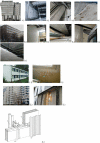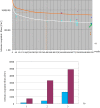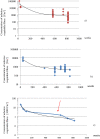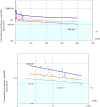The natural reduction of threat in selected systems of old buildings containing asbestos
- PMID: 35173172
- PMCID: PMC8850589
- DOI: 10.1038/s41598-021-04487-y
The natural reduction of threat in selected systems of old buildings containing asbestos
Abstract
The aim of this study was to measure changes in asbestos dust concentrations over extended use in old building systems. Buildings from different systems during their service lifetimes and after asbestos removal were tested. Asbestos dust concentrations decreased in all building systems due to air exchange and other phenomena in the absence of new active dust sources. Currently, with proper use of those buildings, average values of dust concentrations did not exceed 300-400 f/m3 with a downward trend to < 300 f/m3. The results of these studies were obtained with a modified optical microscopy technique, verified by SEM and TEM methods. The graphical trends in concentration changes over longer periods illustrate the potency of opposing factors reducing and increasing indoor air pollution. If removal asbestos work was not carried out carefully, single measurements conducted in the short-term and mandated immediately after asbestos removal may not detect hazards that appear over time. Monitoring buildings over longer periods allows detection of significant contamination changes. In many cases, the minimal air contamination undermines the desirability of removing asbestos in old buildings.
© 2022. The Author(s).
Conflict of interest statement
The author declares no competing interests.
Figures






Similar articles
-
Comparison of the effects of use, protection, improper renovation and removal of asbestos products on the example of typical old office buildings in Poland.Sci Rep. 2023 Aug 21;13(1):13577. doi: 10.1038/s41598-023-37257-z. Sci Rep. 2023. PMID: 37604849 Free PMC article.
-
Pollution of the environment and building interiors during asbestos removal as a result of lack of negative pressure in the working areas.Sci Rep. 2024 Sep 11;14(1):21185. doi: 10.1038/s41598-024-70631-z. Sci Rep. 2024. PMID: 39261502 Free PMC article.
-
Airborne asbestos in buildings.Regul Toxicol Pharmacol. 2008 Mar;50(2):218-25. doi: 10.1016/j.yrtph.2007.10.005. Epub 2007 Oct 12. Regul Toxicol Pharmacol. 2008. PMID: 18006126
-
A review of historical exposures to asbestos among skilled craftsmen (1940-2006).J Toxicol Environ Health B Crit Rev. 2007 Sep-Oct;10(5):319-77. doi: 10.1080/10937400601034191. J Toxicol Environ Health B Crit Rev. 2007. PMID: 17687724 Review.
-
Asbestos exposure in buildings.Clin Chest Med. 1992 Jun;13(2):231-42. Clin Chest Med. 1992. PMID: 1511551 Review.
Cited by
-
Does the Presence of Asbestos-Containing Materials in Buildings Post-construction and Before Demolition Have an Impact on the Exposure to Occupants in Non-occupational Settings?Cureus. 2023 Apr 8;15(4):e37305. doi: 10.7759/cureus.37305. eCollection 2023 Apr. Cureus. 2023. PMID: 37168168 Free PMC article. Review.
-
Comparison of the effects of use, protection, improper renovation and removal of asbestos products on the example of typical old office buildings in Poland.Sci Rep. 2023 Aug 21;13(1):13577. doi: 10.1038/s41598-023-37257-z. Sci Rep. 2023. PMID: 37604849 Free PMC article.
-
Pollution of the environment and building interiors during asbestos removal as a result of lack of negative pressure in the working areas.Sci Rep. 2024 Sep 11;14(1):21185. doi: 10.1038/s41598-024-70631-z. Sci Rep. 2024. PMID: 39261502 Free PMC article.
-
A critical review of asbestos concentrations in water and air, according to exposure sources.Heliyon. 2023 Apr 25;9(5):e15730. doi: 10.1016/j.heliyon.2023.e15730. eCollection 2023 May. Heliyon. 2023. PMID: 37305461 Free PMC article. Review.
References
-
- Upton, A. C. Asbestos in Public and Commercial Buildings—A Literature Revive and Synthesis of Current Knowledge. HEI Health Effect Institute—Asbestos Research, Special Report https://www.healtheffects.org/publication/asbestos-public-and-commercial... (1991).
-
- SRC, Inc. Summary of Published Measurements of Asbestos Levels In Ambient Air. Denver, Colorado: SRC Report prepared for US EPA Region 8, 05//20/2013 https://vdocuments.site/summary-of-published-measurements-of-asbestos-le... (2013).
-
- Kadlewicz K. Testing of the asbestos fibres concentration in the atmosphere at workstations and in the environment. Res. Rep. Min. Environ. Q. 2009;4:19–40.
LinkOut - more resources
Full Text Sources

